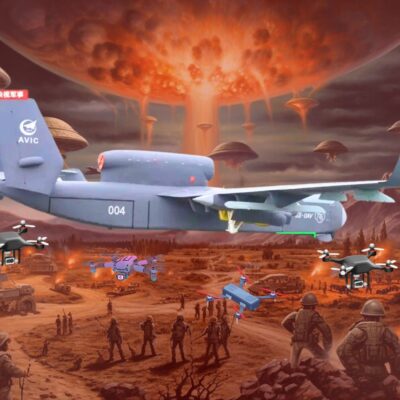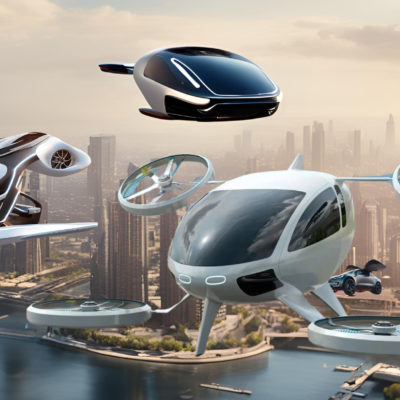Toyota Motor Corporation, in collaboration with Joby Aviation, has achieved a groundbreaking milestone with the first international exhibition flight of their all-electric air taxi in Shizuoka, Japan. This achievement marks a significant step towards transforming air mobility with zero emissions and low noise levels. The all-electric air taxi, designed to carry a pilot and four passengers at speeds of up to 200 mph, aims to reduce traffic congestion and provide eco-friendly transportation solutions for both urban and rural areas. In this article, we will explore the factors making this development interesting and discuss the potential impact on the future of transportation.

The All-Electric Air Taxi: A Closer Look
Toyota and Joby Aviation’s all-electric air taxi represents a leap forward in sustainable air travel. The aircraft’s ability to carry five people (including the pilot) and reach speeds of 200 mph makes it an ideal solution for short to mid-range urban and suburban commutes. This section delves into the key features and capabilities of the air taxi that set it apart from conventional transportation methods.
Design and Specifications
The air taxi boasts several impressive specifications that highlight its innovative design:
- Zero Emissions: As an all-electric vehicle, the air taxi produces no emissions, contributing to cleaner air and a reduction in greenhouse gases.
- Low Noise Levels: The electric propulsion system ensures minimal noise pollution, making the air taxi suitable for use in densely populated urban areas without disturbing residents.
- Speed and Range: Capable of flying at speeds up to 200 mph, the air taxi can cover significant distances quickly, offering a fast and efficient alternative to traditional ground transportation.
- Safety Features: Advanced safety features, including redundant systems and automated flight controls, ensure a safe and reliable travel experience for passengers.
Technological Innovations
The success of the air taxi is driven by several technological innovations:
- Electric Propulsion System: The state-of-the-art electric propulsion system provides efficient and powerful thrust, enabling the air taxi to achieve high speeds and extended range.
- Vertical Takeoff and Landing (VTOL): The VTOL capability allows the air taxi to take off and land vertically, eliminating the need for runways and enabling operations in confined urban spaces.
- Autonomous and Semi-Autonomous Flight: While the air taxi currently requires a pilot, future iterations may incorporate fully autonomous flight capabilities, further enhancing safety and efficiency.
Factors Making This Development Interesting
The successful exhibition flight of the all-electric air taxi has captured the attention of industry experts and the public alike. Several factors contribute to the widespread interest and discussion surrounding this milestone.
Environmental Impact
One of the most compelling aspects of the all-electric air taxi is its potential to significantly reduce the environmental impact of transportation. Traditional aircraft and ground vehicles rely on fossil fuels, which contribute to air pollution and climate change. In contrast, the electric air taxi produces zero emissions, offering a sustainable alternative that aligns with global efforts to combat climate change.
Urban Mobility Solutions
As urbanization continues to accelerate, cities around the world are grappling with the challenges of traffic congestion and inadequate public transportation infrastructure. The all-electric air taxi presents a promising solution to these issues. By leveraging the airspace above cities, the air taxi can alleviate ground traffic congestion and provide a reliable and efficient mode of transportation for urban dwellers.
Technological Advancements
The development of the all-electric air taxi showcases the rapid advancements in aviation and electric vehicle technology. The integration of electric propulsion, VTOL capabilities, and advanced safety systems represents a significant leap forward in the evolution of transportation. These technological breakthroughs have the potential to spur further innovation in the aerospace and automotive industries.
Economic Opportunities
The introduction of all-electric air taxis could create new economic opportunities in various sectors. The production, operation, and maintenance of air taxis will require a skilled workforce, generating jobs and stimulating economic growth. Additionally, the development of supporting infrastructure, such as vertiports and charging stations, will drive investment in urban development and transportation networks.
You might like: Kiwi Cargo Takes Flight: Air New Zealand Unveils Shockingly Electric Plane!
Potential Impact on the Future of Transportation
The successful exhibition flight of the all-electric air taxi marks a pivotal moment in the evolution of transportation. The widespread adoption of air taxis could transform the way people travel, offering numerous benefits and addressing several pressing challenges.
Reducing Traffic Congestion
One of the most significant impacts of air taxis is their potential to reduce traffic congestion in urban areas. By utilizing the vertical and horizontal airspace, air taxis can bypass congested roads and provide a faster and more efficient mode of transportation. This reduction in traffic congestion can lead to shorter commute times, increased productivity, and improved quality of life for city residents.
Enhancing Connectivity
Air taxis have the potential to enhance connectivity between urban centers and remote or underserved areas. Traditional transportation options may be limited or inefficient in certain regions, but air taxis can provide a flexible and reliable solution. This improved connectivity can promote economic development, enhance access to essential services, and bridge the gap between urban and rural communities.
Promoting Sustainable Transportation
The adoption of all-electric air taxis aligns with global efforts to promote sustainable transportation solutions. As countries strive to reduce their carbon footprints and transition to greener alternatives, the widespread use of electric air taxis can contribute to achieving these goals. The reduction in greenhouse gas emissions and air pollution can have a positive impact on public health and the environment.
Driving Innovation and Investment
The development and deployment of air taxis can drive innovation and investment in related technologies and industries. The aerospace sector, in particular, stands to benefit from advancements in electric propulsion, battery technology, and autonomous flight systems. Additionally, the demand for supporting infrastructure, such as vertiports and charging stations, can stimulate investment in urban development and transportation networks.
Related post: The Future of Flying Cars: Electric Vehicles Taking to the Skies
Challenges and Considerations
Whereas the potential benefits of all-electric discuss taxis are noteworthy, a few challenges and contemplations must be tended to to guarantee their effective execution and broad selection.
Regulatory and Safety Standards
The introduction of air taxis will require the establishment of regulatory and safety standards to ensure the safe and efficient operation of these vehicles. Governments and regulatory bodies must work collaboratively with industry stakeholders to develop guidelines and certifications that address the unique characteristics of air taxis. Ensuring public safety and maintaining airspace management are critical considerations.
Infrastructure Development
The successful integration of air taxis into urban environments will necessitate the development of supporting infrastructure. This includes the construction of vertiports, which are specialized facilities for the takeoff, landing, and charging of air taxis. Urban planners and transportation authorities must consider the optimal locations for these facilities and ensure that they are seamlessly integrated into existing transportation networks.
Public Acceptance and Awareness
Gaining public acceptance and awareness of air taxis is crucial for their widespread adoption. Educating the public about the benefits, safety, and reliability of air taxis can help build trust and confidence in this new mode of transportation. Additionally, addressing any concerns or misconceptions through transparent communication and engagement can facilitate a smoother transition.
Economic Viability
The economic viability of air taxis will depend on factors such as production costs, operational expenses, and pricing models. Ensuring that air taxis are affordable and accessible to a broad range of consumers is essential for their success. Manufacturers and operators must explore innovative business models and partnerships to achieve cost efficiencies and deliver value to customers.
Final Thoughts
The successful exhibition flight of Toyota and Joby Aviation’s all-electric air taxi represents a significant milestone in the evolution of transportation. This innovative vehicle has the potential to transform urban mobility, reduce environmental impact, and drive technological advancements. While several challenges and considerations must be addressed, the future prospects for air taxis are promising. By leveraging the benefits of electric propulsion, VTOL capabilities, and advanced safety systems, air taxis can offer a sustainable and efficient solution for the transportation needs of the 21st century.
Read more: Chinese Water Battery Promises Safer and More Energy Storage









Chinese Water Battery Promises Safer and More Energy Storage
Wuling's Mobile Energy Storage Charging Vehicle Can Drive Itself